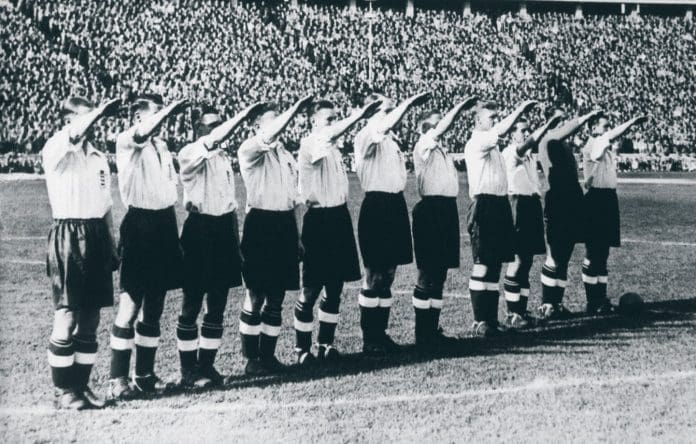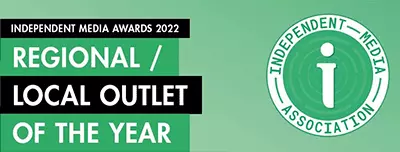On 14 May 1938, in an extraordinary episode of sport being subsumed by diplomacy, the England football team gave the Nazi salute before a friendly international match against Germany in Berlin’s Olympiastadion. The decision, made under pressure from the British Foreign Office, has remained a source of historical controversy and shame.
A Gesture of Appeasement
The match took place at a critical moment in the lead-up to the Second World War. Nazi Germany, under Adolf Hitler, had already begun to consolidate power and territory, most recently through the Anschluss, the annexation of Austria just two months earlier. The British government, led by Prime Minister Neville Chamberlain, was pursuing a policy of appeasement towards the Nazi regime, hoping to maintain peace in Europe by avoiding direct confrontation.
As part of this diplomatic strategy, British officials were determined not to offend the German authorities. The Foreign Office, via the British ambassador in Berlin, Sir Nevile Henderson, ordered the Football Association (FA) to ensure the England team made the Nazi salute during the German national anthem. The intention was to demonstrate goodwill and preserve relations with Hitler’s government, no matter the ethical or political implications.
Reluctance and Obedience
The players were reportedly dismayed by the instruction. Some, including the then-Wolverhampton Wanderers captain Stan Cullis, initially refused to comply. Cullis, known for his forthright nature and moral integrity, allegedly declined to perform the salute and was subsequently dropped from the squad. His biographer later confirmed this account, suggesting that Cullis’s principled stand cost him his place in the team that day.
Other players capitulated, many under protest, and the team was photographed standing in line, arms raised in the fascist salute, just prior to kick-off. The image has since become emblematic of the moral compromises made in the name of diplomacy during the 1930s.
The Political Context
This match was not an isolated gesture but a reflection of deeper sympathies and political trends within the British establishment. Many leading figures in Britain’s aristocracy, business elite, and even elements of the royal family held favourable views of fascist regimes. These were seen as strong, orderly governments capable of resisting the spread of socialism and communism, which were viewed as greater threats to their privileges and class interests.
King Edward VIII, who had abdicated in 1936 to marry American divorcée Wallis Simpson, was one of the most notable fascist sympathisers. After becoming the Duke of Windsor, he visited Hitler in 1937, giving the Nazi salute himself, and later maintained contact with Nazi officials even during the war. Declassified documents suggest he advocated bombing Britain to force peace, believing Germany would inevitably win.
British Fascist Sympathisers
Unity Mitford, an aristocrat and close friend of Hitler, moved to Germany in the early 1930s and became a fervent Nazi supporter. Her antisemitic views were explicit; she once wrote, “I want everyone to know I am a Jew hater.” Her sister Diana married Sir Oswald Mosley, leader of the British Union of Fascists.
Newspaper mogul Lord Rothermere, owner of the Daily Mail, was another outspoken supporter of fascism. In 1934, he published an editorial titled “Hurrah for the Blackshirts,” endorsing Mosley’s movement. Rothermere was also a personal friend of Hitler, with whom he corresponded warmly.
Even Winston Churchill, who would later become the face of British resistance against Nazism, was not immune to the political climate of the time. While deeply suspicious of Hitler’s long-term ambitions, Churchill expressed admiration for the discipline and vigour with which fascist regimes had revived their nations. In a 1935 article, he wrote of Hitler:
“The story of that struggle cannot be read without admiration for the courage, the perseverance, and the vital force which enabled him to challenge, defy, conciliate or overcome all the authority or resistances which barred his path.”
Churchill’s early praise reflected a widespread elite perception of fascism as a modernising force, albeit one they eventually found themselves compelled to resist.
The Match and Its Aftermath
The game itself, played before a crowd of over 100,000, ended in a 6–3 victory for England. Despite the result on the pitch, the legacy of the event remains tarnished by the symbolic defeat off it. The salute was widely criticised in later years, particularly after the full horrors of the Nazi regime were revealed following the war.
In retrospect, the episode is seen not only as a moral failure but also as a grim forewarning of the dangers of appeasement and political blindness. The willingness to bow to authoritarianism in the hope of maintaining peace ultimately emboldened aggressors and delayed the confrontation that was, by then, inevitable.
Sport and Politics
The 1938 Berlin match remains a cautionary tale about the entanglement of sport and politics. It highlights how governments have used sport as a tool of diplomacy, even when doing so compromises ethical standards. The incident also underscores the importance of individual conscience, as displayed by Stan Cullis, in the face of institutional pressure.
Today, the photograph of the England players giving the Nazi salute stands as a potent reminder of a time when fear, class interest, and diplomatic cowardice converged, leaving athletes to perform gestures that history would condemn.







